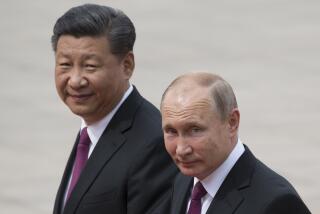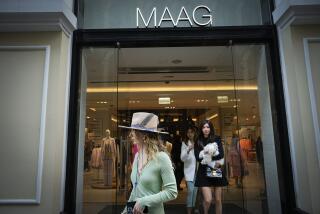Crossing New Frontier at Far East Swap Meet : Commerce: With traders facing off in primitive but dramatic bargaining duels, Russia and China economies become interconnected.
SUIFENHE, China — Rimma Vakarchuk, 29, a resident of the Volga River town of Cheboksary, studied to be a trade economist and worked in that profession until quitting to rear her two children. So what was she doing, dressed in blue jeans and a Benetton T-shirt, buying big bags full of cheap garments in this dusty, sometimes muddy border town in northeastern China?
“I work only for me now, not my country,” Vakarchuk explained, speaking imperfect English and laughing heartily at the absurdity of her situation. “If I go to work, I can have only 2,000 rubles ($14) every month, and I must go to work at 7 and come home at 7. It’s very difficult.”
Instead, she joined a new breed of traders who are turning routes between Russia and China into a new Silk Road. On this, her second business journey to China, she spent $400 dollars to buy clothes and shoes, which she expected to sell in her hometown for $1,100.
After covering expenses of less than $100, she stood to make at least $600 for two weeks’ work. Not bad for a housewife from Cheboksary.
In northeast China and Russia’s Far East, cross-border trade is the most exciting game in town. Here in Suifenhe, the key border crossing of this region, authorities have established a remarkable outdoor market in a dirt field at the edge of town.
Starting at dawn, Russian and Chinese traders face off in primitive but dramatic bargaining duels. Russian traders, typically two dozen or more, gather with their goods in a large ring defined by low wooden tables that serve as a fence. Hundreds of Chinese traders pay about $1 each--$2 if tickets are bought from a scalper--for a spot on the perimeter. From there, waving fistfuls of cash or Chinese-made goods to attract attention, they shout at Russians carrying something they want.
Some speak smatterings of the other’s language. But most bargaining is done by gesture or on calculators.
“I’m willing to trade for anything, as long as it has value and I can sell it,” said Li Haihu, a Chinese man offering Adiads sports shoes, apparently named to trick customers into thinking they were the famed Adidas brand.
Wang Lina, a Chinese shopkeeper on a buying mission from Shenyang, about 400 miles away, was offering shoes, socks and cheap plastic jewelry. “I’ve been here about two weeks,” she said. “The Russians are different people every day. Hardly anyone here today was here yesterday.”
Yuri Serzhantov, 27, from Belarus, was an inside-the-circle trader, selling just one item: an old, gray wool Soviet army jacket. He said he came to Suifenhe with three army jackets and $500 in U.S. currency. “I’ve bought everything--shirts, trousers, shoes,” he said. “I have no job, but I do this trading to Suifenhe, Poland, Turkey, Syria.”
The experiences of private traders reflects what is happening on a larger scale between enterprises. Trade reforms in China, plus the collapse of central planning in Moscow, have brought a sharp falloff in Sino-Russian trade organized out of Moscow and Beijing. But total trade, nurtured by individuals and especially by provincial and local government agencies and enterprises, is expanding.
Total two-way trade between China and Russia ran at $3.2 billion in 1988, the last year before diplomatic ties were fully normalized with former Soviet President Mikhail S. Gorbachev’s 1989 visit to Beijing. It rose to $4.4 billion by 1990, then dropped to $3.9 billion in 1991. Trade between China and all the states of the former Soviet Union during the first half of this year ran slightly above the record 1990 pace. Sino-Russian trade during the first six months of this year was about $2 billion, up 16% over the same period of last year, according to Chinese customs statistics.
Despite a Russian attempt to shift to cash-based trade contracts, much of the exchange here is still done by barter. “It is my opinion that China maybe is the only country in the world with which our trade is increasing, not decreasing,” a Russian diplomat in Beijing commented. “In previous years, the overwhelming proportion was state-to-state trade, and the proportion of border trade (organized by enterprises or local governments in the border regions) was very small. Now the situation is quite different. It is half-and-half.”
Sino-Russian trade, especially between border regions, has a firm foundation and strong prospects for growth because the two nations’ economies are extraordinarily complementary.
“Our reforms caused a great rise in traffic costs on the railroads, and now it is unprofitable for us to bring foodstuffs from Ukraine here,” explained Andrei G. Zagumyonnov, spokesman for the Primorsky Territory International Trade and Foreign Affairs Department. “At the same time, it is expensive for us to send our timber, fish and other goods to western Russia.”
Even Russian-manufactured goods, “which are not in great demand in Japan or the United States, because of their quality, sell quite well in China,” Zagumyonnov noted. “And Chinese goods, which are not wanted in Western countries, sell quite well in our markets. That is why the economies of the Russian Far East and the northeastern provinces of China are more and more interconnected.”
Major Russian imports from China include garments, shoes, foodstuffs and light industrial goods, while key exports to China include fertilizer, cement, steel, timber, passenger cars and frozen fish.
Suifenhe and the neighboring cross-border Russian town of Grodekovo are about 125 miles from Damansky Island, a battleground on the Ussuri River where Soviet and Chinese troops clashed in a historic 1969 fight that bared the Sino-Soviet conflict for all to see. Aftershocks were felt keenly all along the border.
Officials decided that “this piece of border should be locked and there should be no relations here,” noted Pavel M. Korovin, Pogranichny District head. But “since 1989, our relations have improved greatly. We have great prospects in the future.”
In the 1920s and 1930s, Suifenhe was a cosmopolitan Chinese city and an important trading center, with a population of 60,000 and merchants from 18 countries, according to Zhao Lianjun, a Suifenhe official who handles cross-border economic cooperation. The city’s population was only 16,000 in 1980 but has increased since to about 50,000, including temporary residents.
City fathers want to make it a key trading center again, Zhao said. “If you look at a map, Suifenhe isn’t very far from Vladivostok, and it’s convenient for trade with Japan,” he noted.
All signs are that a sustained boom has begun.
But with Russia undergoing wrenching economic change, the growth in trade ties is not always smooth. Because most trade between border region enterprises is conducted by barter, deals typically match items such as Russian fertilizer or cement with Chinese consumer products or food. Some Russian enterprises have found that this year’s radical price reforms have blocked their ability to fulfill contracts.
Chinese, with more than a decade of experience with capitalist-style reforms, often complain that their Russian counterparts don’t understand enough about international trade.
Ma Xingli, a Heilongjiang province trade official in Harbin, noted that some aspects of the economic situations of China and Russia are now reversed compared with 40 years ago, when the Soviet Union was viewed as an “elder brother.”
“In the 1950s, when we traded with them, many of our imports were items needed for daily life,” Ma said. “Now most of our exports are consumer goods. This is a big change.”
Chinese feel pride in such accomplishments, Ma said, adding: “But we also feel that Russia’s difficulties are only temporary. China has a big population and a weak economic base, with much less land than Russia. Their population is smaller. Their educational level is higher. Their industrial base, especially their heavy industry, is rather well-developed. You can’t just compare what’s before your eyes. You ought to look into the future.”
More to Read
Sign up for Essential California
The most important California stories and recommendations in your inbox every morning.
You may occasionally receive promotional content from the Los Angeles Times.










